Defining Ledger Verification Rules
This section provides an overview of ledger verification rules and discusses how to establish ledger verification rules.
Page Used to Define Ledger Verification Rules
|
Page Name |
Definition Name |
Navigation |
Usage |
|---|---|---|---|
|
Ledger Verification Rule |
GC_LEDVERF_RULE |
|
Enables you to specify the Job ID and the period usage for ledger verification rules. |
Understanding Ledger Verification Rules
After you load your ledgers you must verify that the content of the ledger data adheres to balancing rules that you specify, such as debits equal credits. You use the standard PeopleSoft EPM metadata tools to build these balance rules. After the balancing rules are defined, you then associate them with the ledger verification rules component that is delivered with Global Consolidations. The Ledger Verification application engine resolves these rules, and creates status log entries that you view with the Ledger Preparation Manager.
You run the ledger verification process at the beginning of the edger preparation process. The ledger verification process validates the data for specified source business units based on user-defined rules for checks and balances and error handling. If an error occurs during the verification, the Ledger Preparation engine will either continue the ledger preparation process for the valid business units only, or abort the entire run, (depending on what you specify for Verification Error Handling on the Ledger Preparation Run Group page). You can view the verification status results on the Ledger Preparation Manager page.
Note: You must run ledger verification for all source data.
See Understanding the Ledger Preparation Manager.
Defining Ledger Verification Rules
Ledger verification rules are based on balancing rule equations, such as debits equal credits. These equations are defined using metadata, including filters, constraints, and job total metadata, which is then processed through the reconciliation engine. You define a balancing rule equation and add it to a ledger verification rule by following these steps:
Define filters and constraints for each side of the balancing rule equation.
Use the constraints to define job total metadata for each side of the equation.
Use job total metadata to define the balancing rule metadata.
Add the job total metadata IDs to Global Consolidations Ledger Verification Rules.
After the ledger verification rules are defined, you then add them to the ledger preparation rules and run the ledger preparation process. .
Delivered Sample Metadata
Global Consolidations delivers the following balancing rule sample data for standard balance rules that you can access and modify to assist you with building your own ledger verification rules:
Total debits equal total credits.
Current period retained earnings equals prior period retained earnings plus current period activity.
Assets equal liabilities plus equity.
Exclude future periods.
Prior period source count equals prior period source staging ledger (SLED) count.
You should adjust the verification rules according to your data and use those rules that make sense for your business practices. In addition to the user-defined rules, the verification process can optionally perform basic ChartField validation against the ChartField Edit on the Ledger Template. You can also create additional rules for verifying your source ledger data.
Global Consolidations delivers the following sample metadata to support manual data entry:
TableMaps
DataMaps
Filters and Constraints
Job Total Metadata
Balance Rule Metadata
Global Consolidations delivers the following sample TableMap metadata to support ledger verification for source manual ledgers:
|
TableMaps |
Primary Table Name |
Description |
|---|---|---|
|
GCLEDMANL |
GC_LEDMANL_F00 |
Source Ledger records for user defined spreadsheet upload/manual entry ledger. |
|
GCSLEDMANL |
GC_SLED_MANL |
Prep Source Ledger - Manual Global Consolidations Preparation Source Ledger for source ledgers from user defined spreadsheet upload/manual entry ledgers. |
Global Consolidations delivers the following sample DataMap metadata support ledger verification for source manual ledgers:
|
DataMaps |
Constraint Codes |
Constraint Description |
|---|---|---|
|
GCSLEDMANL |
GC_SLEDMANL_NONE |
Manual ledger no mapping |
|
GCLEDMPRVSLEDCNT |
Prior period SLED count |
|
|
GCRECNLEDMSRC |
Preparation manual source |
|
|
GCRECNMCALMAP |
Calendar map - manual |
|
|
GCLEDMANL |
GCLEDMASSET |
Source asset amount |
|
GCLEDMCREDIT |
Source credit amount |
|
|
GCLEDMCURACTIVITY |
Source current activity |
|
|
GCLEDMCURRETN |
Source current retained earnings |
|
|
GCLEDMDEBIT |
Source debit amount |
|
|
GCLEDMFUTPERIOD |
Reconciliation future activities |
|
|
GCLEDMLIABEQUITY |
Source liability plus equity |
|
|
GCLEDMPRVBAL |
Source prior balance |
|
|
GCLEDMPRVSRCCNT |
Prior period source count |
|
|
GCRECNMCALSRC |
Calendar source - manual |
Global Consolidations delivers the following sample constraints and filters to support ledger verification for source manual ledgers:
|
Constraint |
Description |
Filter Code |
|---|---|---|
|
GC_SLEDMANL_NONE |
Manual ledger no mapping |
None |
|
GCLEDMPRVSLEDCNT |
Prior period SLED count |
GCLEDMPRVSLEDCNT |
|
GCRECNLEDMSRC |
Preparation manual source |
GCRECNLEDMSRC |
|
GCRECNMCALMAP |
Calendar map - manual |
GCRECNMCALMAP |
|
GCLEDMASSET |
Source asset amount |
GCLEDMASSET |
|
GCLEDMCREDIT |
Source credit amount |
GCLEDMCREDIT |
|
GCLEDMCURACTIVITY |
Source current activity |
GCLEDMCURACTIVITY |
|
GCLEDMCURRETN |
Source current retained earnings |
GCLEDMCURRETN |
|
GCLEDMDEBIT |
Source debit amount |
GCLEDMDEBIT |
|
GCLEDMFUTPERIOD |
Reconciliation future activities |
GCLEDMFUTPERIOD |
|
GCLEDMLIABEQUITY |
Source liability plus equity |
GCLEDMLIABEQUITY |
|
GCLEDMPRVBAL |
Source prior balance |
GCLEDMPRVBAL |
|
GCLEDMPRVSRCCNT |
Prior period source count |
GCLEDMPRVSRCCNT |
|
GCRECNMCALSRC |
Calendar source - manual |
GCRECNMCALSRC |
Note: You will find the sample constraints and filters under the SHARE SetID.
Global Consolidations delivers the following sample Job Total Metadata to support ledger verification for source manual ledgers:
|
Job ID |
Total ID |
Description |
Record Name |
Constraint Code |
|---|---|---|---|---|
|
GCRECNCAL |
TOT6 |
Calendar map - manual |
GC_SLED_MANL |
GCRECNMCALMAP |
|
GCRECNCLED |
TOT4 |
Preparation manual source |
GC_SLED_MANL |
GCRECNLEDMSRC |
|
GCVERFLEDM |
GC_PRVSLED |
Prior period SLED count |
GC_SLED_MANL |
GCLEDMPRVSLEDCNT |
|
GCRECNCAL |
TOT5 |
Calendar source - manual |
GC_LED_MANL_F00 |
GCRECNMCALSRC |
|
GCVERFLEDM |
GC_ASSETS |
Assets |
GC_LED_MANL_F00 |
GCLEDMASSET |
|
GCVERFLEDM |
GC_CREDIT |
Credit amount |
GC_LED_MANL_F00 |
GCLEDMCREDIT |
|
GCVERFLEDM |
GC_CURACT |
Current period activity |
GC_LED_MANL_F00 |
GCLEDMCURACTIVITY |
|
GCVERFLEDM |
GC_CURRETN |
Current period retained earnings |
GC_LED_MANL_F00 |
GCLEDMCURRETN |
|
GCVERFLEDM |
GC_DEBIT |
Debit amount |
GC_LED_MANL_F00 |
GCLEDMDEBIT |
|
GCVERFLEDM |
GC_FUTCNT |
Future periods count |
GC_LED_MANL_F00 |
GCLEDMFUTPERIOD |
|
GCVERFLEDM |
GC_LIABEQT |
Liabilities plus equity |
GC_LED_MANL_F00 |
GCLEDMLIABEQUITY |
|
GCVERFLEDM |
GC_PRVBAL |
Prior period balance |
GC_LED_MANL_F00 |
GCLEDMPRVBAL |
|
GCVERFLEDM |
GC_PRVCNT |
Prior period source count |
GC_LED_MANL_F00 |
GCLEDMPRVSRCCNT |
|
GCVERFMNL2 |
GC_CREDIT |
Credit |
GC_LED_MANL_F00 |
GCLEDMCREDIT |
|
GCVERFMNL2 |
GC_DEBIT |
Debit |
GC_LED_MANL_F00 |
GCLEDMDEBIT |
Note: You will find the sample Job Total Metadata under the SHARE SetID.
Global Consolidations delivers the following sample Balance Rules Metadata to support ledger verification for source manual ledgers:
|
Balance Rules Metadata ID |
Description |
|---|---|
|
GCVERFLEDM |
GC_LEDMANL_F00 acceptance rule |
|
GCVERFMNL2 |
GC_LEDMANL minimum acceptance |
Note: You will find the sample Balance Rules Metadata under the SHARE SetID.
Example: Metadata Setup for Ledger Verification
The following example demonstrates how a standard balance rule for the source manual ledger GC_LEDMANL_F00 record is defined for debits must equal credits.
This balance rule forms an equation that contains two terms.
Total Debits = Total Credits
The system calculates each one of these terms using job total metadata.
Note: This example presumes that the record metadata, tablemap, and datamap are already setup.
The first step is to set up the filters and constraints for the balance rule equation. In this example, two filters were established, one for each side of the balance rule equation, as follows:
This illustrates the GCLEDMDEBIT filter criteria page, which calculates the left side of the equation and selects debit data:
Image: Filter - Selection Criteria page for the GCLEDMDEBIT filter
This example illustrates the fields and controls on the Filter - Selection Criteria page for the GCLEDMDEBIT filter. You can find definitions for the fields and controls later on this page.
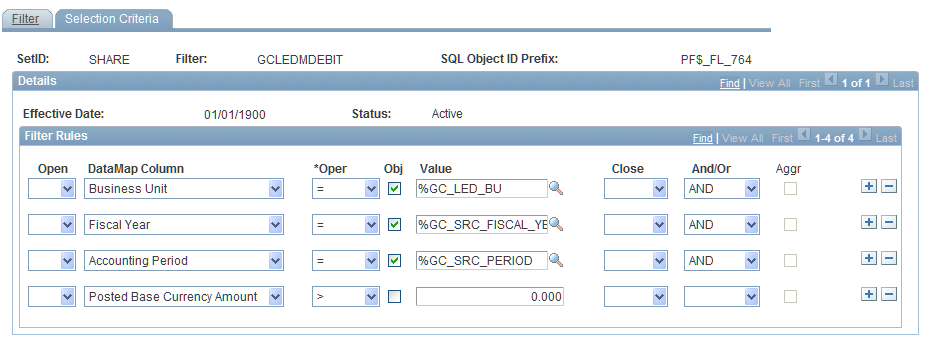
This illustrates the GCLEDMCREDIT filter criteria page, which selects the right side of the balance rule equation, credit data:
Image: Filter - Selection Criteria page for GCLEDMCREDIT
This example illustrates the fields and controls on the Filter - Selection Criteria page for GCLEDMCREDIT. You can find definitions for the fields and controls later on this page.
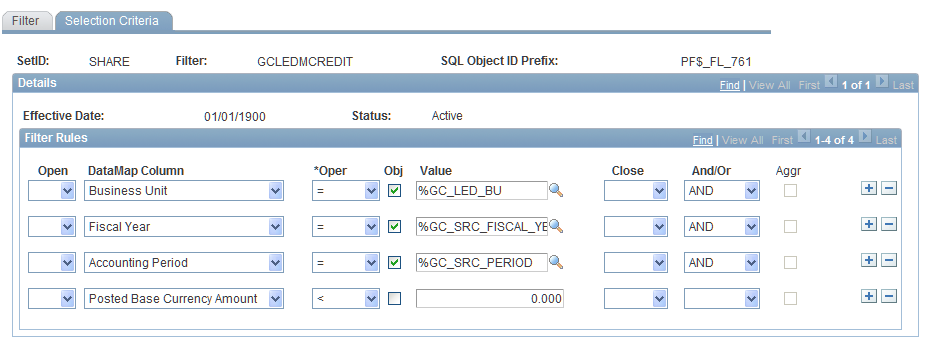
Note: Unless you have modified the underlying fields and tables, there is no need to modify these filters.
The two previously described filters were then associated with constraints, as follows:
This illustrates the constraint that was established to use the debit filter.
Image: Constraint - Criteria page for GCLEDMDEBIT Filter
This example illustrates the fields and controls on the Constraint - Criteria page for GCLEDMDEBIT Filter. You can find definitions for the fields and controls later on this page.
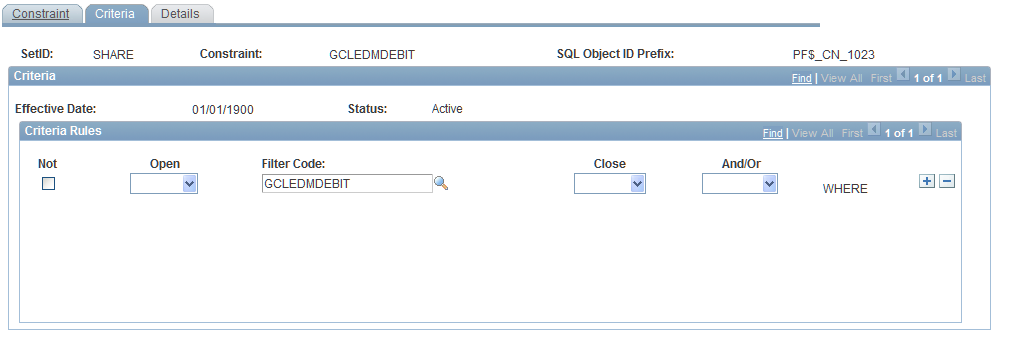
This illustrates the constraint that was established to use the credit filter:
Image: Constraint - Criteria page for GCLEDMCREDIT Filter
This example illustrates the fields and controls on the Constraint - Criteria page for GCLEDMCREDIT Filter. You can find definitions for the fields and controls later on this page.
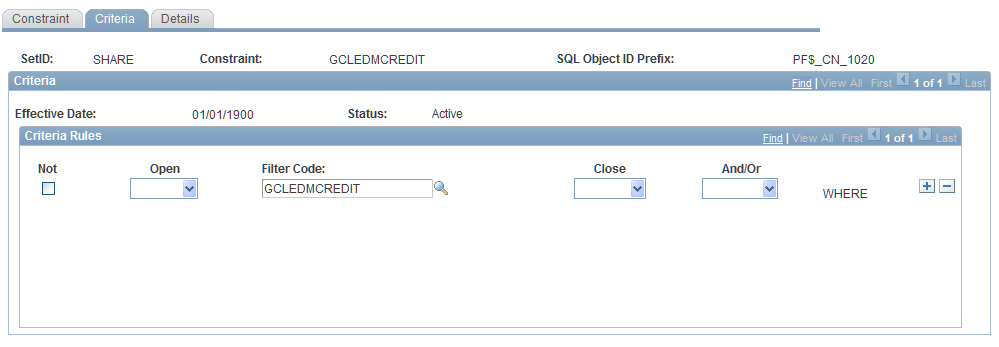
Note: There is no need to modify these constraints even if you modify the filters that are associated with them, unless you have changed the names of the filters.
With the filters and constraints in place, the next step is to establish Total IDs for both the credit and debit constraints on the Job Total Metadata page. The Total ID's are also associated with a Job ID on the Job Total Metadata page. Because the both the debit and credit calculations are used during the ledger verification process, they are established for the Global Consolidations Manual Ledger Verification Job ID, GCVERFLEDM.
This illustrates the Job Total Metadata page for the Total ID GC_DEBIT, that uses the GCLEDMDEBIT constraint:
Image: Job Total Metadata page for GC_DEBIT
This example illustrates the fields and controls on the Job Total Metadata page for GC_DEBIT. You can find definitions for the fields and controls later on this page.

This illustrates the Job Total Metadata page for the Total ID GC_CREDIT that uses the GCLEDMCREDIT constraint:
Image: Job Total Metadata page for GC_Credit
This example illustrates the fields and controls on the Job Total Metadata page for GC_Credit. You can find definitions for the fields and controls later on this page.
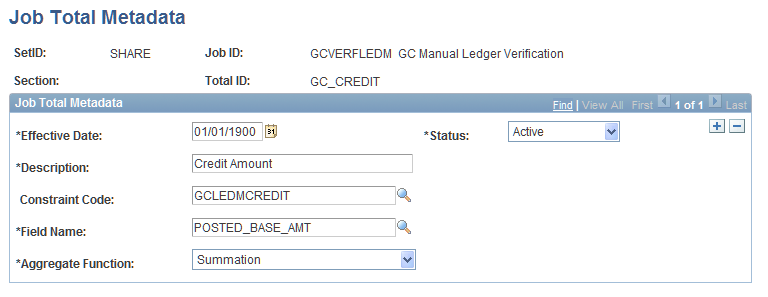
Note: There is no need to modify the job total metadata even if you modify the filters and constraints that are associated with them. The only reason to modify this metadata is if you have added new filters and constraints that you want to use.
The next step is to use the Job IDs and Total IDs to establish the Balance Rules Metadata, as follows.
This illustrates the balances rules metadata for debits = credits.
Image: Balances Rules Metadata page
This example illustrates the fields and controls on the Balances Rules Metadata page. You can find definitions for the fields and controls later on this page.

The final step is to associate the Job ID from the Balance Rules Metadata with a ledger verification rule. In this example, the balance rules metadata, GCVERFLEDM is associated with the ledger verification rule GC_VERF1.
Image: Ledger Verification Rule page
This example illustrates the fields and controls on the Ledger Verification Rule page. You can find definitions for the fields and controls later on this page.
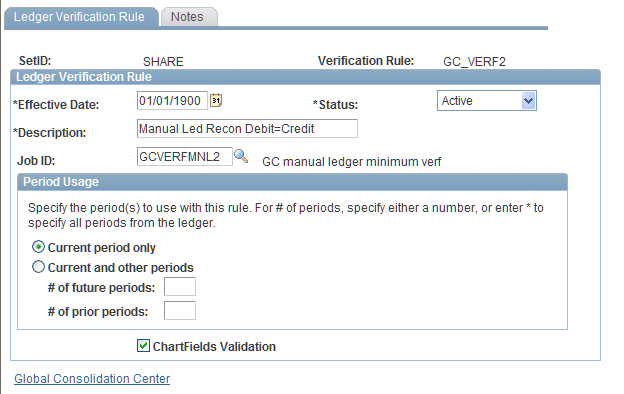
The preceding example illustrates how EPM metadata is setup to verify that the debits equal the credit. . This is one of several basic accounting principle rules that are delivered as sample EPM metadata and that you can use or modify to suit your business practices.
Ledger Verification Rule Page
Use the Ledger Verification Rule page (GC_LEDVERF_RULE) to enables you to specify the Job ID and the period usage for ledger verification rules.
Image: Ledger Verification Rule page
This example illustrates the fields and controls on the Ledger Verification Rule page. You can find definitions for the fields and controls later on this page.

Note: To perform ChartField validation, you must specify a TSE record for use on the Ledger Template Consolidation Variables setup page. The delivered TSE record for the manual data entry process is GC_TSE_MANL_FLD.
See Defining Spreadsheet/Manual Entry Ledger Templates.
See Defining Ledger Templates.
Period Usage